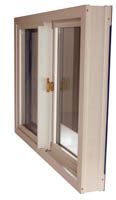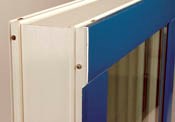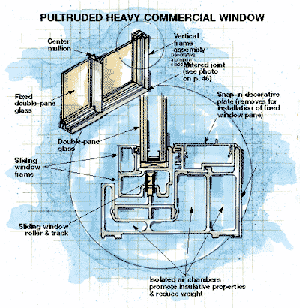Pultruded Heavy Commercial Window an Industry First
Composites add strength and insulating value, improving occupant comfort and reducing energy cost.
|
Engineering Challenge: Design an operable heavy commercial window that can meet stricter proposed standards for insulation and reduce building energy consumption Design Solution: Replace conventional aluminum frame with pultruded frame, designed with molded-in features that enhance frame strength, reduce window weight and meet requirements for thermal performance. |
Commercial buildings in the U.S. are said to consume 30 percent of the energy used in the country each year. To reduce America's energy consumption and dependence on fossil fuels, the U.S. Department of Energy's (DOE) goal is to reduce energy usage in buildings by 50 percent by 2010. Stricter energy codes proposed by the International Energy Conservation Council (IECC) stipulate that an insulating value or U-factor equal to or less than 0.35 thermal transmittance (the same thermal performance rating already required for residential windows) be put in place for commercial windows in Northern climate zones (the lower the U-factor, the more thermally and energy efficient the window.)
In anticipation of new standards, EFCO Corp. (Monett, Mo.), a manufacturer of aluminum commercial windows since the 1950s, began work on a new window design. Commercial windows are typically much larger than residential windows and are made with extruded aluminum frames that are thermally broken — that is, the outer frame is separated by insulating material like urethane or plastic and does not touch the inside frame, to reduce transfer of heat or cold. To achieve an equivalent 0.35 U-factor residential rating, a commercial window would need to either be triple-glazed (adding a third pane of glass), greatly increasing the cost and weight, or require an expensive heat mirror (a low-emissivity coated film suspended between two panes of glass). "We recognized that you can only tweak an aluminum window so much to keep up with today's higher industry standards for thermal efficiency," says EFCO president Chris Fuldner. "The glass industry has progressed tremendously over the last 20 years, and now it's our turn to make the framework equivalent in terms of energy performance."
EFCO initially considered vinyl, but found that it was not strong enough to carry the loads of a large commercial window, explains EFCO design engineer Steve Cantrell. Aware that windows made from pultruded composite frame members could achieve significant energy savings, EFCO looked at pultruded components for their windows but was unable, at first, to find profiles that had an acceptable architectural finish. It decided to use pultruded components from Tecton Products (Fargo, N.D.) after seeing samples from the company. Tecton, a manufacturer of pultruded fiberglass composites since 1992, began as a partnership between its president, John Jambois, and Marvin Windows and Doors. Tecton specializes in complex thin-walled pultrusions for the fenestration and other industries. The company partnered with EFCO on the design of the pultruded E-Shield heavy commercial window.
DEVELOPING A BETTER WINDOW
Size and wind load requirements are the main differences between residential and heavy commercial windows — the latter are typically larger and deeper and have higher load requirements. Although windows don't bear structural weight from the building, wind load is a critical factor. Tecton engineers worked closely with EFCO's Cantrell to design a fiberglass window frame that met structural, wind, water leakage and deflection requirements for the newly proposed 0.35 U-factor-rated heavy commercial window.
EFCO engineers laid out a paper drawing to establish the basic design. American Architectural Manufacturers Assn. (AAMA) requirements stipulate that a commercial window must withstand wind load pressure up to 1.5 times the specified design pressure. (AAMA is the largest and most active independent certification and inspection agency in the U.S. and participates in writing standards and procedures.) "A window experiences pressure from both directions — inside and outside," says Cantrell. To meet AAMA specifications, a "gateway"-sized prototype (2.44m by 1.98m or 8-ft by 6.5-ft, the size specified in test requirements) with two panes of glass weighing about 122.5 kg/270 lb was designed to withstand more than 5,000 lb of pressure, distributed over the entire window.
The design resulted in a thin-walled pultruded frame profile with hollows. The glass reinforcement and the profile geometry provide enough strength to bear the windowpane glass load while the hollows form discreet insulating cells within the profile that minimize heat transfer and convection currents. Frame depth was 13.34 cm/5.25 inches (with 8.9-cm/3.5-inch sight-lines around the frame), with wall thicknesses averaging 0.32 cm/0.125 inches. The sash component (the inner, movable window frame that slides open) measures 5.25 cm/2.0625 inches deep.
An important design issue was how to assemble the frame and make the mitered edges watertight. Since composites can't be welded like aluminum, 10.6 cm by 10.6 cm (4-inch by 4-inch) right angle-shaped composite components, called corner keys, were designed to slip into the end of each lineal component. Four corner keys were used to hold the outer frame together and four smaller corner keys were used to hold the sash corners. When inserted, the keys create a watertight seal and hold the corners of the frame in a stable 90° alignment. For the main frame, corner keys averaged 12.7 cm/5 inches wide, while the corner keys for the sash averaged 4.60 cm/1.8125 inches wide.
The greatest challenge was to design a window that met performance requirements while meeting cost realities. Tecton used Pro/ENGINEER (Pro-E) CAD design software, from PTC (Needham, Mass.), to design and simulate window performance. Using the software's Pro/MECHANICA module, loads and stresses were applied to simulate what could happen with different forces, recalls Tecton design engineer Robb Willgohs. Pro-E allowed the engineers to change window size and integrate design changes immediately. "With the software we could quickly design and test a virtual window and be relatively positive that the end product would turn out as the simulation showed," adds Lee Assenheimer, Tecton's market development manager. Tecton engineers confirmed overall structural performance with finite element analysis (FEA). FEA also enabled virtual testing of individual components to minimize wall thickness for cost purposes while identifying areas of weakness where additional reinforcements were needed.
PROTOTYPE AND TESTING
The next step was a prototype. Fiberglass mat and rovings, impregnated with unsaturated polyester resin, were pulled through a heated, hardened steel die designed and built by Tecton. The profiles were coated inline with Tecton's patented Durion acrylic finish before being cut to 4.9m/16-ft lengths. The finish reportedly adds weatherability to the pultrusion as well as providing a smooth, consistent finish. This technology was one of the key reasons that EFCO chose to partner with Tecton.
The profiles were shipped to EFCO, where lineal components were miter-cut to size. At the same time, a firm in Texas injection molded the corner keys, made from glass-reinforced nylon. After the frame elements were cut to size, the corner keys were inserted into the ends of each frame part; parts were joined into frames and then assembled as finished windows. The pieces were mechanically fastened using stainless steel screws. In addition, the corners were sealed and bonded with silicone caulking material supplied by Dow Corning (Midland, Mich.).
|
EFCO then tested the prototype at its onsite testing facility with a certified technician. A certification test was conducted in accordance with North American Fenestration Standard "Voluntary Performance Specifications for Windows, Skylights and Glass Doors" (NASF-02) on the gateway window. To achieve a heavy commercial (HC) rating, a product must be subjected to a series of tests. First is an air leakage test with a test pressure of 6.24 psf with maximum allowable leakage of no more than 0.3 cubic feet per minute per ft2. The prototype tested with an air leakage of 0.055 per cubic feet per minute per ft2, well below the maximum allowable. Next, a water test was conducted. HC products must be tested to a minimum of 15 percent of the design pressure. The overall goal for the prototype was to achieve the HC-65 rating, in which 65 designates the applicable design load. Based on the 65 design load, 15 percent of design load would require a water test pressure of 47.6 kg/m2 (9.75 lb/ft2). The prototype passed a test at 48.8 kg/m2 (10 lb/ft2). The pressure helps identify leaks and ensures that the water troughs channel water away efficiently. Finally, the window was submitted to a uniform load deflection test requiring that no member of the window deflect more than L over 175 (a formula for figuring the deflection for any member; "L" is the length of the member). It was also subjected to a forced entry and deglazing (removing the glass) test. All tests were passed and the window achieved the HC-65 rating. |
THERMAL PERFORMANCE
The low thermal conductivity and seal integrity of the frame resulted in a 23 percent improvement in condensation resistance factor (CRF) over the thermally broken aluminum frame's CRF.
Because the frame is made from fiberglass, the frame and the glass windowpanes have a similar coefficient of thermal expansion (CTE), readily maintaining frame-to-seal integrity and reducing the potential for air infiltration, a major cause of U-factor deterioration and subsequent water damage in aluminum frames.
The National Fenestration Rating Council (NFRC) writes and enacts window energy performance standards, with help from AAMA, for the industry to provide reliable and accurate information to consumers. A second smaller test version window, measuring 1,500 mm by 1,200 mm (59.06 inches by 47.24 inches) was sent to ATI (York, Pa.), an independent testing facility, and was used in NFRC simulations, where the thermal performance was tested and verified. The pultrusions' dimensional stability met all the climatic temperature range requirements, from -29°C to 82°C (-20°F to 180°F). The test must stay within a set standard of simulation numbers before commercialization, says Cantrell. The window passed certification and AAMA provided EFCO with a 507-03 thermal performance report showing the U-value of their window with different types of glass. Based on the numbers put into the report, EFCO will not have to retest the window for each type of glass.
To further test the thermal performance of the frame, Kansas State University (Manhattan, Kan.) conducted "thermal comfort" studies to simulate and compare the windows framed with a Tecton profile versus a thermally broken aluminum frame. The model measures whether a room occupant feels too cold or too warm wearing a normal amount of clothing. Tests showed that at -18°C/0°F outside, an occupant could sit within 25 cm/1 ft of the window with a Tecton frame and be in a cool but comfortable temperature range (15°C to 17°C or 60°F to 63°F). By contrast, the temperature 1 ft from the therm- ally broken aluminum frame window was not considered tolerable (11°C to 14°C or 52°F to 58°F). For a thermally broken aluminum frame to achieve similar results, heat output would need to be increased, raising energy costs by as much as 15 percent, according to the study.
The production model EFCO E-Shield commercial window meets the proposed 0.35 U-factor requirement with a 25 mm/1-inch insulated low-E glass unit. A comparable thermally broken aluminum window with a 1-inch insulated low-E glass unit would have a U-factor of approximately 0.53, 33 percent higher.
As the first heavy commercial window to achieve a U-factor rating of 0.35, Assenheimer maintains, the E-Shield has the potential to reduce energy consumption in a building by an estimated 6 to 8 percent.
Related Content
COMPINNOV TP2 project promotes use of thermoplastics in aerospace
Completed in 2023, COMPINNOV TP2 explored thermoplastic composites, enhancing the understanding between prepregs and production methods to foster the potential for French aerospace innovation.
Read MoreMFFD thermoplastic floor beams — OOA consolidation for next-gen TPC aerostructures
GKN Fokker and Mikrosam develop AFP for the Multifunctional Fuselage Demonstrator’s floor beams and OOA consolidation of 6-meter spars for TPC rudders, elevators and tails.
Read MoreSmartValves offer improvements over traditional vacuum bag ports
Developed to resolve tilting and close-off issues, SmartValves eliminate cutting through vacuum bags while offering reduced process time and maintenance.
Read MoreCompPair adds swift prepreg line to HealTech Standard product family
The HealTech Standard product family from CompPair has been expanded with the addition of CS02, a swift prepreg line.
Read MoreRead Next
“Structured air” TPS safeguards composite structures
Powered by an 85% air/15% pure polyimide aerogel, Blueshift’s novel material system protects structures during transient thermal events from -200°C to beyond 2400°C for rockets, battery boxes and more.
Read MoreAll-recycled, needle-punched nonwoven CFRP slashes carbon footprint of Formula 2 seat
Dallara and Tenowo collaborate to produce a race-ready Formula 2 seat using recycled carbon fiber, reducing CO2 emissions by 97.5% compared to virgin materials.
Read MoreDeveloping bonded composite repair for ships, offshore units
Bureau Veritas and industry partners issue guidelines and pave the way for certification via StrengthBond Offshore project.
Read More
























